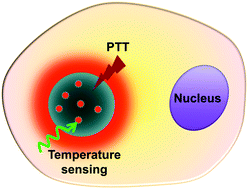Facile synthesis of polypyrrole–rhodamine B nanoparticles for self-monitored photothermal therapy of cancer cells†
Abstract
Photothermal therapy following microscopic temperature detection can avoid overheating effects or insufficient heating, and thus improve therapeutic efficacy. In this study, biocompatible dual-functional nanoparticles (NPs) are constructed from polypyrrole (PPy) and rhodamine B (RB) by a one-step modified polymerization method. The polypyrrole serves as a photothemal agent, and rhodamine B acts as a temperature-sensing probe. The polypyrrole–rhodamine B (PPy–RB) NPs possess a high photothermal effect on irradiation by 808 nm laser, and a competent temperature sensitivity for the real-time temperature monitoring based on the emission intensity response of rhodamine B. After acting on HepG2 cells, the PPy–RB NPs can effectively induce cancer cell death, and the microscopic temperature is monitored by fluorescence feedback from rhodamine B during PTT by laser confocal microscopy. Hence, the proposed approach can supply a facile and promising way for the fabrication of effective theranostic nanoplatforms assisted by self-monitoring of cancer therapeutic processes.



 Please wait while we load your content...
Please wait while we load your content...